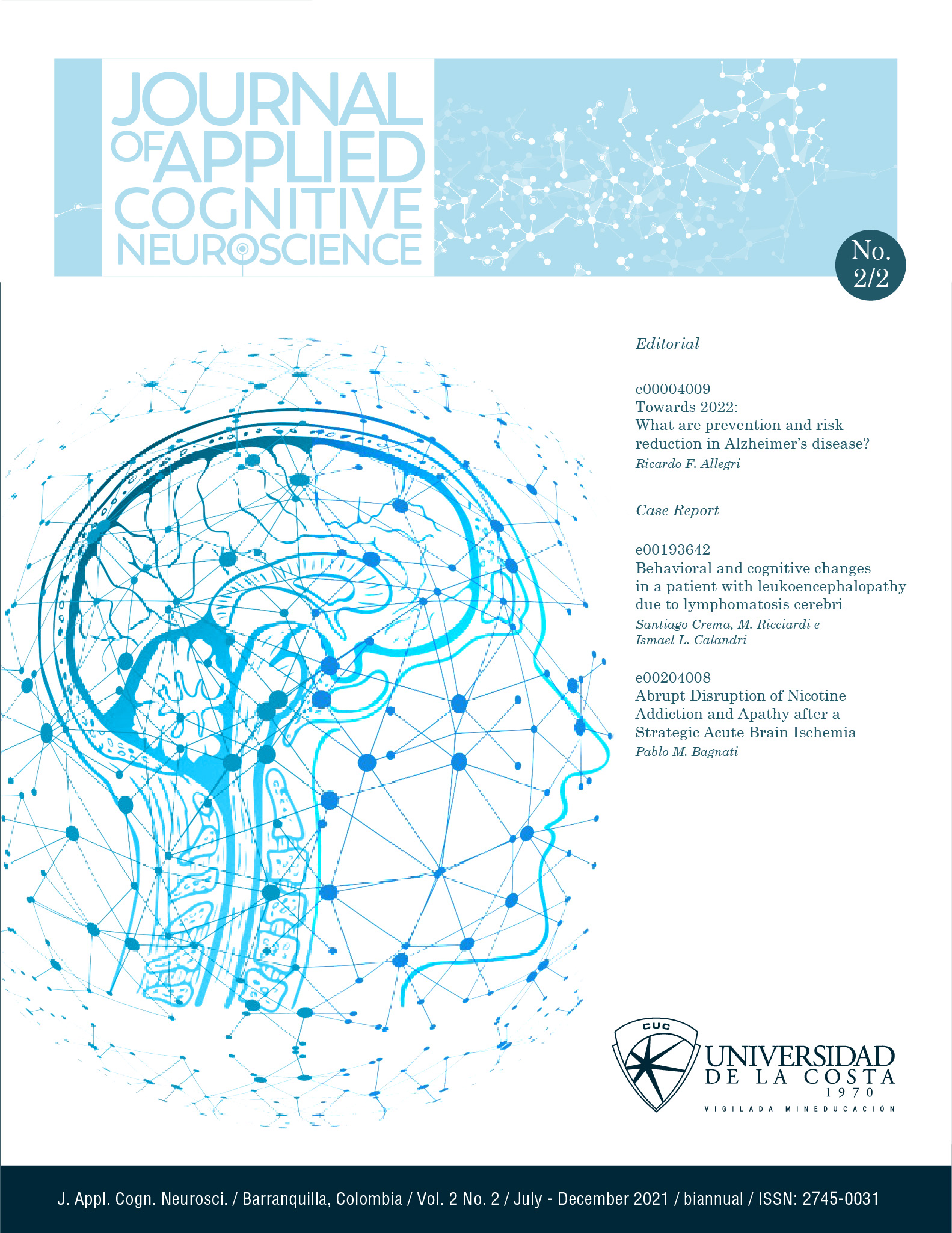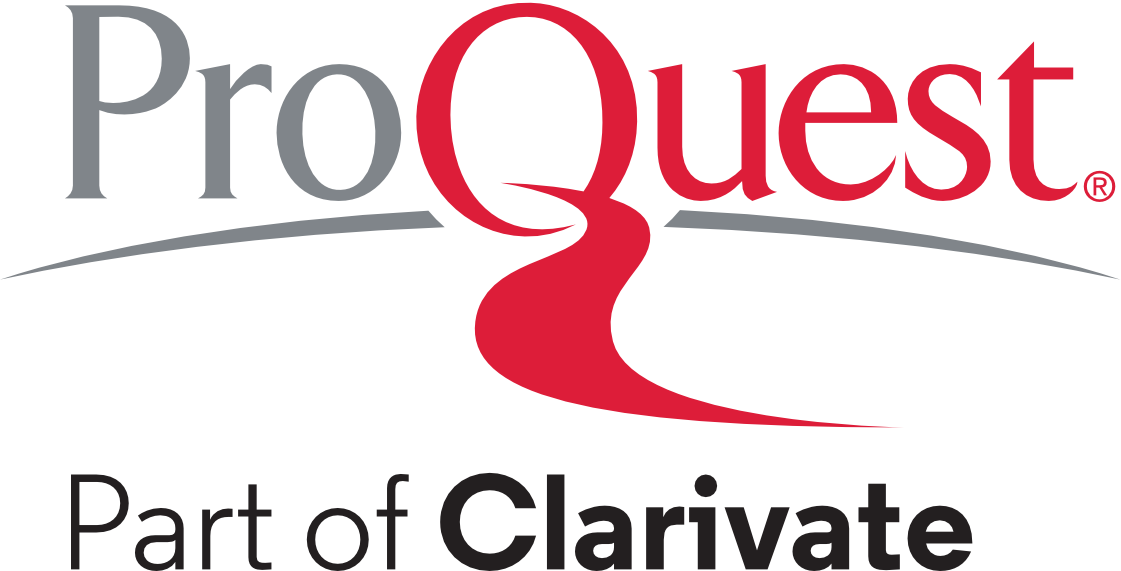Towards 2022: What are prevention and risk reduction in Alzheimer’s disease?
Hacia 2022: ¿Qué son la prevención y la reducción de riesgos en la enfermedad de Alzheimer?
DOI:
https://doi.org/10.17981/JACN.2.2.2021.00Palabras clave:
Alzheimer’sDescargas
Citas
Bateman, R. J.; Xiong, C.; Benzinger, T.; Fagan, A. M.; Goate, A.; Fox, N. C.; Marcus, D. S.; Cairns, N. J.; Xie, X., Blazey, T. M.; Holtzman, D. M.; Santacruz, A.; Buckles, V.; Oliver, A.; Moulder, K.; Aisen, P. S.; Ghetti, B.; Klunk, W. E.; McDade, E.; Martins, R. N.; Masters, C. L.; Mayeux, R.; Ringman, J. M.; Rossor, M. N.; Schofield, P. R.; Sperling, R. A.; Salloway, S. & Morris, J. C. (2012). Clinical and Biomarker Changes in Dominantly Inherited Alzheimer’s disease. The New England Journal of Medicine, 367(9), 795–804.
https://doi.org/10.1056/NEJMoa1202753
Brookmeyer, R.; Johnson, E.; Ziegler-Graham, K. & Arrighi, H. M. (2007). Forecasting the global burden of Alzheimer’s disease. Alzheimer’s & Dementia, 3(3), 186–191.
https://doi.org/10.1016/j.jalz.2007.04.381
Cummings, J.; Lee, G.; Zhong, K.; Fonseca, J. & Taghva, K. (2021). Alzheimer’s disease drug development pipeline: 2021. Alzheimer’s Dement, 7(1), 1–24.
https://doi.org/10.1002/trc2.12179
Feinleib, M. (2001). A Dictionary of Epidemiology, Fourth Edition - Edited by John M. Last, Robert A. Spasoff, and Susan S. Harris. American Journal of Epidemiology, 154(1), 93–94.
https://doi.org/10.1093/aje/154.1.93-a
Getsios, D.; Blume, S.; Ishak, K. J.; Maclaine, G. & Hernández, L. (2012). An economic evaluation of early assessment for Alzheimer’s disease in the United Kigdom. Alzheimer & Dementia, 8(1), 22–30.
https://doi.org/10.1016/j.jalz.2010.07.001
Hodes, J. F.; Oakley, C. L.; O’Keefe, J. H.; Lu, P.; Galvin, J. E.; Saif, N.; Bellara, S.; Rahman, A.; Kaufman, Y.; Hristov, H.; Rajji, T. K.; Fosnacht, A. M.; Patel, S.; Merrill, D. A.; Kaiser, S.; Meléndez-Cabrero, J.; Melendez, J. A.; Krikorian, R. & Isaacson, R. S. (2019). Alzheimer’s “Prevention ”vs.“ Risk Reduction: Transcending Semantics for Clinical Practice. Frontiers in Neurology, 9(1), 1–8.
https://doi.org/10.3389/fneur.2018.01179
Kivipelto, M.; Mangialasche, F.; Snyder, H. M.; Allegri, R. F.; Andrieu, S.; Arai, H.; Baker, L.; Belleville, S.; Brodaty, H.; Brucki, S. M.; Calandri, I.; Caramelli, P.; Chen, C.; Chertkow, H.; Chew, E.; Choi, S. H.; Chowdhary, N.; Crivelli, L.; De La Torre, R.; Du, Y.;Dua, T.; Espeland, M.; Feldman, H. H.; Hartmanis, M.; Hartmann, T.; Heffernan, M.; Henry, C. J.; Hong, C. H.; Håkansson, K.; Iwatsubo, T.; Jeong, J. H.; Jimenez-Maggiora, G.; Koo, E. H.; Launer, L. J.; Lehtisalo, J.; Lopera, F.; Martínez-Lage, P.; Martins, R.; Middleton, L.; Molinuevo, J. L.; Montero-Odasso, M.; Moon, S. Y.; Morales-Pérez, K.; Nitrini, R.; Nygaard, H. B.; Park, Y. K.; Peltonen, M.; Qiu, C.; Quiroz, Y. T.; Raman, R.; Rao, N.; Ravindranath, V.; Rosenberg, A.; Sakurai, T.; Salinas, R. M.; Scheltens, P.; Sevlever, G.; Soininen, H.; Sosa, A. L.; Suemoto, C. K.; Tainta-Cuezva, M.; Velilla, L.; Wang, Y.; Whitmer, R.; Xu, X.; Bain, L. J.; Solomon, A.; Ngandu, T. & Carrillo, M. C. (2020). World-Wide FINGERS Network: A Global Approach to Risk Reduction and Prevention of Dementia. Alzheimers & Dement, 16(1), 1078–1094.
https://doi.org/10.1002/alz.12123
McKhann, G.; Drachman, D.; Folstein, M.; Katzman, R.; Price, D. & Stadlan, E. M. (1984). Clinical diagnosis of Alzheimer’s disease: report of the NINCDS-ADRDAWork Group under the auspices of Department of Health and Human Services Task Force on Alzheimer’s disease. Neurology, 34(7), 939–944.
https://doi.org/10.1212/wnl.34.7.939
McKhann, G. M.; Knopman, D. S.; Chertkow, H.; Hyman, B. T.; Jack, C. R. Jr, Kawas, C. H, Klunk, W. E; Koroshetz, W. J.; Manly, J. J.; Mayeux, R.; Mohs, R. C.; Morris, J. C.; Rossor, M. N.; Scheltens, P.; Carrillo, M. C.; Thies, B.; Weintraub, S. & Phelps, C. H. (2011). The diagnosis of dementia due to Alzheimer’s disease: recommendations from the National Institute on Aging– Alzheimer’s Association workgroups on diagnostic guidelines for Alzheimer’s disease. Alzheimers Dement, 7(3), 263–269.
https://doi.org/10.1016/j.jalz.2011.03.005
Prince, M.; Bryce, R. & Ferri, C. (2011). World Alzheimer Report 2011. The benefits of early diagnosis and intervention. London: ADI. Available:
https://www.alzint.org/resource/world-alzheimer-report-2011/
Sperling, R. A.; Aisen, P. S.; Beckett, L. A.; Bennett, D. A.; Craft, S.; Fagan, A. M.; Iwatsubo, T.; Jack Jr, C. R.; Kaye, J.; Montine, T. J.; Park, D. C.; Reiman, E. M.; Rowe, C. C.; Siemers, E.; Stern, Y.; Yaffe, K.; Carrillo, M. C.; Thies, B.; Morrison-Bogorad, M.; Wagster, M. V. & Phelps, C. H. (2011). Towards defining the preclinical stages of Alzheimer’s disease: recommendations from the National Institute on Aging–Alzheimer’s Association workgroups on diagnostic guidelines for Alzheimer’s disease. Alzheimers Dement, 7, 280–292.
https://doi.org/10.1016/j.jalz.2011.03.003
WHO EMRO. (feb. 1, 2015). Health Promotion and Disease Prevention Through Population-Based Interventions, Including Action to Address Social Determinants and Health Inequity. Genebra: Regional Director/WHO. Available:
http://www.emro.who.int/about-who/public-health-functions/health-promotion-disease-prevention.html
WHO. (2012). Dementia: A Public Health Priority. London: WHO/ADI. Available:
https://apps.who.int/iris/handle/10665/75263
Wimo, A. & Prince, M. (2010). World Alzheimer Report 2010. London: ADI. Available from
https://www.alz.org/documents/national/world_alzheimer_report_2010.pdf
Descargas
Publicado
Cómo citar
Número
Sección
Licencia
Derechos de autor 2021 Journal of Applied Cognitive Neuroscience

Esta obra está bajo una licencia internacional Creative Commons Atribución-NoComercial-SinDerivadas 4.0.
Usted es libre de:
1. Compartir - copiar y redistribuir el material en cualquier medio o formato.
2. El licenciante no puede revocar estas libertades siempre que usted respete los términos de la licencia.
Bajo los siguientes términos:
1. Atribución - Usted debe dar el crédito apropiado, proporcionar un enlace a la licencia, e indicar si se hicieron cambios. Puede hacerlo de cualquier manera razonable, pero no de forma que sugiera que el licenciante le respalda a usted o a su uso.
2. NoComercial - No puede utilizar el material con fines comerciales.
3. NoDerivados - Si remezcla, transforma o construye sobre el material, no puede distribuir el material modificado.
4. Sin restricciones adicionales - Usted no puede aplicar términos legales o medidas tecnológicas que restrinjan legalmente a otros de hacer cualquier cosa que la licencia permita.


 English
English
 Español (España)
Español (España)










